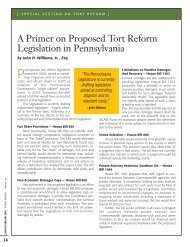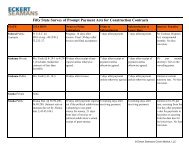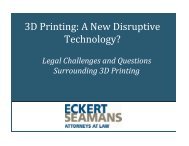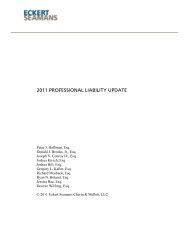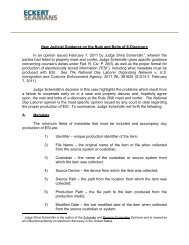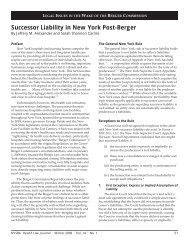of reasonable diligence. The standard of reasonable diligence isobjective, not subjective. It is not a standard of reasonablediligence unique to a particular Plaintiff, but instead, a standard ofreasonable diligence as applied to a “reasonable person.”Id. at 167; see also Radman v. Gaujot, 53 Fed. Appx. 606 (3d Cir. 2002) (not precedential) (thehappening of the breach and the injured party’s awareness of the breach, not his knowledge ofthe resulting damage, is the focus of Pennsylvania law) Igbonwa v. Cameron, 2004 U.S. Dist.LEXIS 2128 (E.D. Pa. 2004) (in order to qualify for the discovery rule, a plaintiff must havemade reasonable efforts to protect his own interests, and must show why he was unable todiscover the facts necessary to plead the cause of action); Foueke v. Dugan, 187 F. Supp. 2d 253(E.D. Pa. 2002) (to bring a claim outside of the statute of limitations, a plaintiff faces the burdenof demonstrating that his claim falls into one of the exceptions to the occurrence rule); Amorosov. Morley, No. 00-3496, 2002 U.S. Dist. LEXIS 4989 (E.D. Pa. Mar. 25, 2002) (the statute oflimitations is tolled only if a person in the plaintiff’s position exercising reasonable diligencewould not have been aware of the salient facts) (citing Baily v. Lewis, 763 F. Supp. 802, 806(E.D. Pa. 1991), aff’d, 950 F.2d 721 (3d Cir. 1991); Edwards v. Duane, Morris & Heckscher,LLP, et al., No. 01-4798, 2002 U.S. Dist. LEXIS 16301 (E.D. Pa. Aug. 15, 2002) (discovery rulemay be applied to breach of contract actions “where the injured party is unable, despite theexercise of due diligence to know of an injury or its cause”); cf. Fine v. Checcio, 870 A.2d 850(Pa. 2005) (medical malpractice case in which Supreme Court held that “discovery rule appliesto toll the statute of limitations in any case where a party neither knows nor reasonably shouldhave known of his injury and its cause at the time his right to institute suit arises” and rejectedargument that rule should not extend statute of limitations in any case where cause of injury isdiscovered within original statutory period.)In Whitley v. Allegheny County, No. 07-403, 2008 U.S. Dist. LEXIS 28739 (W.D. Pa.Mar. 24, 2008), Plaintiff filed the instant action in March 2007 and asserted, inter alia, a statelaw claim for professional negligence against his criminal defense attorney (“Defense attorney”).By way of background, Defense attorney represented Plaintiff in the first of two petitions ofpost-conviction relief (“PCRA”) and not the underlying criminal trial. The initial PCRA petitionwas denied. Id. Plaintiff subsequently filed a second PCRA petition. Plaintiff informed thecourt that he was no longer represented and requested appointment of counsel. Different counselwas appointed; but Defense attorney did not formally withdraw. Plaintiff alleged that thecriminal Defense attorney disregarded his duty to Plaintiff by failing to communicate withPlaintiff and failing to perform a proper investigation, which resulted in Plaintiff suffering aprolonged incarceration.The court noted, “[the parties] agree[d] that the appropriate starting point for a legalmalpractice action arising for an underlying criminal representation commences at thetermination of the attorney-client relationship.” However, the parties disagreed as to when theattorney-client relationship terminated. Defense attorney maintained that the relationship endedwhen the first PCRA petition was dismissed and new counsel was appointed; therefore,Plaintiff’s claims fell outside the two year statute of limitations. In response, Plaintiff contendedthat the relationship continued until the denial of the second PCRA petition, approximately tenmonths prior to Plaintiff filing the instant action.160
In finding Plaintiff’s claims barred, the court noted that Plaintiff petitioned the court toappoint new counsel to represent him in the appeal of the first PCRA petition in 1999. After newcounsel was appointed in December 1999, Plaintiff was no longer represented by Defensecounsel. Therefore, the court noted that the termination of the attorney-client relationshipoccurred on the date of appointment of new counsel. Accordingly, the court found Plaintiff’sclaims against Defense attorney were barred by the statute of limitations.In Wachovia Bank, N.A. v. Ferretti, 935 A.2d 565 (Pa. Super. Ct. 2007), the SuperiorCourt examined when a cause of action for legal malpractice accrues when an attorney failed tomark a judgment as satisfied. The Superior Court reiterated that “the trigger for the accrual of alegal malpractice action, for the statute of limitations purposes, is not the realization of actualloss, but the occurrence of a breach of duty.” Id. at 572. The court explained that an exceptionto the occurrence rule is the equitable discovery rule, which provides the statute of limitations istolled when the “injured party is unable, despite the exercise of due diligence, to know of theinjury or its cause.” The court cautioned, “[l]ack of knowledge, mistake or misunderstandingwill not toll the running of the statute.” Id. The Superior Court stressed that Pennsylvania doesnot follow the actual loss rule, where the statute of limitations is tolled in the legal malpracticesuit until a final judgment is entered in the underlying lawsuit. Id.The Superior Court explained that the statute of limitations began to run when theattorney failed to mark the judgment as satisfied, that is, when the attorney breached a duty. Id.Furthermore, the court stated that the equitable discovery rule could only toll the statute oflimitations until the time when the client was informed that a proceeding was being institutedagainst them regarding judgment that their attorney failed to mark as satisfied. Id. at 574. Thecourt recognized that the occurrence rule requires the filing of a legal malpractice claim beforethe client in the underlying claim knows whether he will suffer any damages as a result of hisattorney’s negligence. Id. at 574 The court stated while there is a dilemma in taking competingpositions in the underlying claim and the legal malpractice claim, the public policy concern ofavoiding stale claims must prevail over the public policy concern over having two casessimultaneously proceed with inconsistent positions. Id. The court reasoned, “[t]he purpose ofthe statute would not be served if an attorney is kept in the state of breathless apprehension whilea former client pursues appeal from the trial court, to the Court of Appeal, to the Supreme Court .. . during which time memories fade, witnesses disappear or die, and evidence is lost. Id. Insum, the public policy concern of raising stale legal malpractice claims requires the filing of aclaim for legal malpractice at the time of the breach of a duty. The statute of limitations willonly be tolled under the doctrine of equitable discovery until the time clients are made aware ofproceedings against them, even if the clients are uncertain whether they will prevail in defendingthe underlying claim.”The United State Court of Appeals for the Third Circuit addressed the applicabilityof the discovery rule to legal malpractice claims in Knopick v. Connelly, 639 F.3d 600 (3dCir. 2011). In Knopick, the plaintiff hired the Connelly defendants to represent him in alawsuit involving a motion to set aside a separation and property agreement between himand his wife. His wife alleged the plaintiff failed to disclose two million dollars worth ofstock prior to entering the agreement. The plaintiff informed the defendants of fourwitnesses who could testify as to his wife’s knowledge of the assets. At the August 2, 2004hearing, the defendants called no witnesses, and assured the plaintiff the agreement would161
- Page 3 and 4:
EMTALA CASES ......................
- Page 5:
Filing an Affidavit of Non-Involvem
- Page 8 and 9:
II.PROFESSIONAL LIABILITY - AN OVER
- Page 10 and 11:
The Superior Court reversed the tri
- Page 12 and 13:
to a third party pursuant to the st
- Page 14 and 15:
After approximately five months, De
- Page 16 and 17:
learned the day after the surgery t
- Page 18 and 19:
conduct to the delay in colon cance
- Page 20 and 21:
court admitted the expert’s testi
- Page 22 and 23:
(b)(c)other reasonable causes, incl
- Page 24 and 25:
corroborated his testimony. The cou
- Page 26 and 27:
husband’s estate. Plaintiff alleg
- Page 28 and 29:
Other notable federal cases arising
- Page 30 and 31:
The Superior Court found that in re
- Page 32 and 33:
§ 1303.512(b). The court, however,
- Page 34 and 35:
In Neidig v. United States, No. 07-
- Page 36 and 37:
Additionally, the Supreme Court not
- Page 38 and 39:
were not indicated for her conditio
- Page 40 and 41:
surgeon is the same as it would be
- Page 42 and 43:
It should be noted that the Superio
- Page 44 and 45:
Finally, the court held that the tr
- Page 46 and 47:
The Supreme Court of Pennsylvania r
- Page 48 and 49:
nurses deviating from applicable st
- Page 50 and 51:
certainty, the court reviews expert
- Page 52 and 53:
Under Pennsylvania law, the Court n
- Page 54 and 55:
testimony, Defendant presented his
- Page 56 and 57:
Following Cooper v. Roberts, 286 A.
- Page 58 and 59:
Plaintiff developed chronic diarrhe
- Page 60 and 61:
where payment is made by Medicaid w
- Page 62 and 63:
accomplished. In Valles v. Albert E
- Page 64 and 65:
In 1980, the Pennsylvania Superior
- Page 66 and 67:
Plaintiff had a routine monitoring
- Page 68 and 69:
Plaintiff’s Contract ClaimsThe Co
- Page 70 and 71:
is a failure to report changes in a
- Page 72 and 73:
unit to assure post-surgical patien
- Page 74 and 75:
sliced his wrist and arm with a raz
- Page 76 and 77:
licensed professionals for whom the
- Page 78 and 79:
(c)Limitations of Corporate Neglige
- Page 80 and 81:
Even more recently, our Superior Co
- Page 82 and 83:
(a)HMO IssuesIn McClellan v. Health
- Page 84 and 85:
affidavit submitted by Defendants o
- Page 86 and 87:
treatments while at VA’s faciliti
- Page 88 and 89:
[s]ubstantively, we believe that a
- Page 90 and 91:
The party claiming the benefit of t
- Page 92 and 93:
deprive (him) of civil rights guara
- Page 94 and 95:
found that the District Court was w
- Page 96 and 97:
With respect to fraudulent concealm
- Page 98 and 99:
would be applied in situations wher
- Page 100 and 101:
they had not raised them in the cou
- Page 102 and 103:
(a)Informed ConsentUnder MCARE, a p
- Page 104 and 105:
civil enforcement provisions and ma
- Page 106 and 107:
MCARE also changes the manner in wh
- Page 108 and 109:
whose death, in 2005, was allegedly
- Page 110 and 111:
vicariously liable if the plaintiff
- Page 112 and 113:
health center or its equivalent or
- Page 114 and 115:
In Pennsylvania Medical Society, th
- Page 116 and 117: to any professional who is alleged
- Page 118 and 119: Since the 2005 amendments, there ha
- Page 120 and 121: ule, but who intentionally ignores
- Page 122 and 123: the original Complaint was delivere
- Page 124 and 125: foreclose all challenges against th
- Page 126 and 127: number of boxes), which was support
- Page 128 and 129: questions of professional judgment
- Page 130 and 131: deviated from any professional stan
- Page 132 and 133: The Third Circuit affirmed the Dist
- Page 134 and 135: claims and cross-claims remain agai
- Page 136 and 137: By an Amendatory Order dated March
- Page 138 and 139: The court acknowledged that there i
- Page 140 and 141: apply and that the trial court misa
- Page 142 and 143: Barbados had enough litigation-spec
- Page 144 and 145: E. Preemption of Vaccine Design Def
- Page 146 and 147: 2. Pa. R. Civ. Pro. 1036.1 - Reinst
- Page 148 and 149: Barrick, at *34-35.Furthermore, the
- Page 150 and 151: (b) the utility of the defendant’
- Page 152 and 153: 2006). In this case, Plaintiffs bro
- Page 154 and 155: B. Elements of a Cause of Action fo
- Page 156 and 157: decision in Muhammad precluded Mr.
- Page 158 and 159: considered speculative “only if t
- Page 160 and 161: underlying cause of action involved
- Page 162 and 163: In Capital Care Corp., the Superior
- Page 164 and 165: The court found, however, to state
- Page 168 and 169: not be set aside. On July 7, 2005,
- Page 170 and 171: complete bar to recovery. Since a l
- Page 172 and 173: On appeal, Plaintiffs claimed that
- Page 174 and 175: In Liggon-Redding, 659 F.3d at 265,
- Page 176 and 177: elieved of those minimum standards
- Page 178 and 179: elevant to the proceedings, the com
- Page 180 and 181: establish professional misconduct b
- Page 182 and 183: Upholding the Superior Court’s Or
- Page 184 and 185: Id.Rejecting revocation and suspens
- Page 186 and 187: order as a sanction under Rule 4019
- Page 188: {1009912]182




